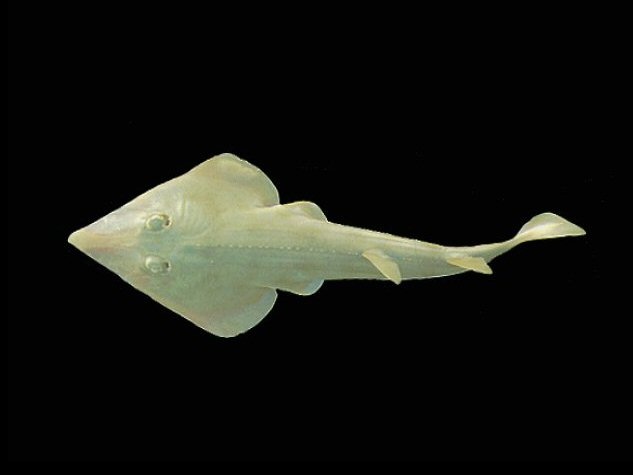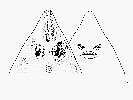Pseudobatos productus
(Ayres, 1854)
Shovelnose guitarfish
Classification: Elasmobranchii Rhinopristiformes Rhinobatidae
Reference of the original description
(Description of new fishes from California.) Proceedings of the California Academy of Sciences, (Series 1), 1, 3–22
(Description of new fishes from California.) Proceedings of the California Academy of Sciences, (Series 1), 1, 3–22
Image of the original description
No image in first description.
No image in first description.
Synonyms / new combinations and misspellings
Rhinobatis producta, Rhinobatis productus, Rhinobatos cf. productus, Rhinobatos productus, Rhinobatus producta, Rhinobatus productus
Rhinobatis producta, Rhinobatis productus, Rhinobatos cf. productus, Rhinobatos productus, Rhinobatus producta, Rhinobatus productus
Description :
Citation: Pseudobatos productus (Ayres, 1854): In: Database of modern sharks, rays and chimaeras, www.shark-references.com, World Wide Web electronic publication, Version 01/2026
Please send your images of "Pseudobatos productus" to info@shark-references.com

Pseudobatos productus (Ayres, 1854), © Centro Interdisciplinario de Ciencias Marinas (CICIMAR-IPN) http://coleccion.cicimar.ipn.mx

Pseudobatos productus (Ayres, 1854), © Centro Interdisciplinario de Ciencias Marinas (CICIMAR-IPN) http://coleccion.cicimar.ipn.mx
Common names
 Guitarra trompa pala,
Guitarra trompa pala,  Guitarra viola,
Guitarra viola,  Poisson-guitare spatule,
Poisson-guitare spatule,  Guitarfish,
Guitarfish,  Pointed-nose guitarfish,
Pointed-nose guitarfish,  Shovel-nose shark,
Shovel-nose shark,  Shovelnose guitarfish
Shovelnose guitarfish
 Guitarra trompa pala,
Guitarra trompa pala,  Guitarra viola,
Guitarra viola,  Poisson-guitare spatule,
Poisson-guitare spatule,  Guitarfish,
Guitarfish,  Pointed-nose guitarfish,
Pointed-nose guitarfish,  Shovel-nose shark,
Shovel-nose shark,  Shovelnose guitarfish
Shovelnose guitarfish
Short Description
Broad disc is greater in length than width; a relatively smooth dorsal surface except for a single row of thorns around the eyes and extending along the back and tail; a long, pointed snout with a rounded tip; small, rounded, pebble-like teeth; a first dorsal fin that originates closer to the pelvic fin base than to the caudal fin origin; a thick tail and a moderately large caudal fin without a distinct lower lobe. Tooth count: 102-112/98-117. Spiral valve count: 8-10.
Broad disc is greater in length than width; a relatively smooth dorsal surface except for a single row of thorns around the eyes and extending along the back and tail; a long, pointed snout with a rounded tip; small, rounded, pebble-like teeth; a first dorsal fin that originates closer to the pelvic fin base than to the caudal fin origin; a thick tail and a moderately large caudal fin without a distinct lower lobe. Tooth count: 102-112/98-117. Spiral valve count: 8-10.
Distribution
Eastern Pacific: endemic to the eastern Pacific from San Francisco, USA to the Gulf of California, and possibly to Mazatlan, Mexico (Ref. 48844). Source: www.gbif.org
Eastern Pacific: endemic to the eastern Pacific from San Francisco, USA to the Gulf of California, and possibly to Mazatlan, Mexico (Ref. 48844). Source: www.gbif.org
Human uses
fisheries: commercial; gamefish: yes
fisheries: commercial; gamefish: yes
Biology
Exhibit ovoviparity (aplacental viviparity), with embryos feeding initially on yolk, then receiving additional nourishment from the mother by indirect absorption of uterine fluid enriched with mucus, fat or protein through specialised structures [733]. Adults of both sexes congregate during the breeding season in shallow bays and estuaries and likewise leave when the pupping season is over after mating (Ref. 48844). Gestation lasts for about 12 months (Ref. 48844).
Exhibit ovoviparity (aplacental viviparity), with embryos feeding initially on yolk, then receiving additional nourishment from the mother by indirect absorption of uterine fluid enriched with mucus, fat or protein through specialised structures [733]. Adults of both sexes congregate during the breeding season in shallow bays and estuaries and likewise leave when the pupping season is over after mating (Ref. 48844). Gestation lasts for about 12 months (Ref. 48844).
Size / Weight / Age
119 cm TL (male/unsexed; (Ref. 48844)); 170 cm TL (female); max. published weight: 9,750 g (Ref. 40637); max. published weight: 18 kg; max. reported age: 16 years (Ref. 48844)
119 cm TL (male/unsexed; (Ref. 48844)); 170 cm TL (female); max. published weight: 9,750 g (Ref. 40637); max. published weight: 18 kg; max. reported age: 16 years (Ref. 48844)
Habitat
demersal; brackish; marine; depth range 1 - 91 m (Ref. 48844), usually 1 - 13 m (Ref. 48844)
demersal; brackish; marine; depth range 1 - 91 m (Ref. 48844), usually 1 - 13 m (Ref. 48844)
Remarks
shark-references Species-ID=14586;
shark-references Species-ID=14586;
Parasites (arranged by Jürgen Pollerspöck)
Monogenea
Cestoda
Trematoda
Nematoda
Copepoda
Monogenea
- Anoplocotyloides papillatus (Doran, 1953) Young, 1967 [11689] [17104]
- Rhinobatonchocotyle cyclovaginatus Doran, 1953 [11689]
- Spinuris lophosoma Doran, 1953 [11689] [17104] [23771] [26032]
Cestoda
- Acanthobothrium dujardinii Van Beneden, 1849 [16448]
- Acanthobothrium olseni Dailey & Mudry, 1968 [16176] [28741]
- Acanthobothrium rhinobati Alexander, 1953 [16173] [16175] [16448] [28741]
- Acanthobothrium robustum Alexander, 1953 [16173] [16175] [16448] [28741]
- Acanthobothrium southwelli Subhapradha, 1955 [16448]
- Dollfusiella schmidti (Heinz & Dailey, 1974) Beveridge, Neifar & Euzet, 2004 [16323] [16112]
- Lacistorhynchus dollfusi Beveridge & Sakanari, 1987 [16112]
- Parachristianella monomegacantha Kruse, 1959 [16184] [16112]
- Prochristianella fragilis Heinz & Dailey, 1974 [16323] [16112]
- Pseudochristianella nudiscula Campbell & Beveridge, 2006 [10844] [23771]
Trematoda
- Anaporrhutum euzeti Curran, Blend & Overstreet, 2003 [23771]
Nematoda
- Phlyctainophora squali Mudry & Dailey, 1969 [15949]
Copepoda
- Eudactylina dactylocerca Deets, 1994 [17867]
- Kroyerina deborahae Deets, 1987 [15948]
- Norkus cladocephalus Dojiri & Deets, 1988 [17060]
- Trebius latifurcatus Wilson, 1921 [14624]

















